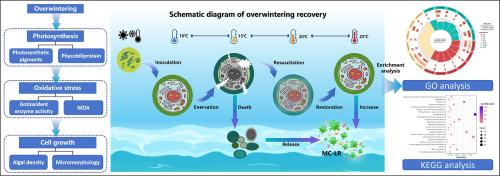当前位置:
X-MOL 学术
›
Water Res.
›
论文详情
Our official English website, www.x-mol.net, welcomes your
feedback! (Note: you will need to create a separate account there.)
From Winter Dormancy to Spring Bloom: Regulatory Mechanisms in Microcystis aeruginosa Post-Overwintering Recovery
Water Research ( IF 11.4 ) Pub Date : 2024-11-17 , DOI: 10.1016/j.watres.2024.122807 Chenjun Fu, Xinyi Wang, Jing Yu, Hu Cui, Shengnan Hou, Hui Zhu
Water Research ( IF 11.4 ) Pub Date : 2024-11-17 , DOI: 10.1016/j.watres.2024.122807 Chenjun Fu, Xinyi Wang, Jing Yu, Hu Cui, Shengnan Hou, Hui Zhu

|
Cyanobacterial blooms pose a significant environmental threat in freshwater ecosystems. These cyanobacteria exhibit resilience to cold and dark conditions during winter and flourish as temperature rise in warmer seasons. However, there is a limited understanding of the dynamic growth recovery process and regulatory signaling mechanisms in cyanobacteria after overwintering. In this study, we employed Microcystis aeruginosa (M. aeruginosa) as a model to simulate its growth recovery when subjected to increasing temperature after overwintering under low temperature (4 °C) and dark conditions. We investigated changes in cell growth, microcystin levels, and signaling pathways throughout this recovery phase. Our results indicated that compared to the non-overwintering treatment (T1), the overwintered treatment (T2) experienced a 55.6% decrease in algae density and a significant reduction in microcystin-LR (MC-LR) levels within the 15-20 °C temperature range (p < 0.05). Overwintering suppressed photosynthetic efficiency during the recovery phase of M. aeruginosa, activated the antioxidant system, and impaired cellular ultrastructure, making algal cells more vulnerable to death. At the transcriptional level, overwintering down-regulated pathways such as photosynthesis, ribosome, the Calvin cycle, and oxidative phosphorylation, hindering the growth and metabolic capacity of M. aeruginosa. In conclusion, this study highlights the inhibitory impacts of overwintering on growth and metabolism of cyanobacteria during the recovery process. It provides insights into the mechanistic foundations of seasonal cyanobacterial blooms and the crucial role of signaling regulation in these processes.
中文翻译:

从冬眠到春花:铜绿微囊藻越冬后恢复的调控机制
蓝藻水华对淡水生态系统构成重大环境威胁。这些蓝藻在冬季表现出对寒冷和黑暗条件的适应能力,并在温暖的季节随着温度的升高而蓬勃发展。然而,对越冬后蓝藻的动态生长恢复过程和调节信号机制的了解有限。本研究以铜绿微囊藻 (M. aeruginosa) 为模型,模拟其在低温 (4 °C) 和黑暗条件下越冬后温度升高时的生长恢复。我们研究了整个恢复阶段细胞生长、微囊藻毒素水平和信号通路的变化。我们的结果表明,与非越冬处理 (T1) 相比,越冬处理 (T2) 在 15-20 °C 温度范围内藻类密度降低了 55.6%,微囊藻毒素-LR (MC-LR) 水平显着降低 (p < 0.05)。越冬抑制了铜绿分枝杆菌恢复期的光合效率,激活了抗氧化系统,损害了细胞超微结构,使藻类细胞更容易死亡。在转录水平上,越冬下调光合作用、核糖体、卡尔文循环和氧化磷酸化等途径,阻碍铜绿分枝杆菌的生长和代谢能力。总之,本研究强调了越冬对恢复过程中蓝藻生长和代谢的抑制作用。它提供了对季节性蓝藻水华的机制基础以及信号调节在这些过程中的关键作用的见解。
更新日期:2024-11-17
中文翻译:

从冬眠到春花:铜绿微囊藻越冬后恢复的调控机制
蓝藻水华对淡水生态系统构成重大环境威胁。这些蓝藻在冬季表现出对寒冷和黑暗条件的适应能力,并在温暖的季节随着温度的升高而蓬勃发展。然而,对越冬后蓝藻的动态生长恢复过程和调节信号机制的了解有限。本研究以铜绿微囊藻 (M. aeruginosa) 为模型,模拟其在低温 (4 °C) 和黑暗条件下越冬后温度升高时的生长恢复。我们研究了整个恢复阶段细胞生长、微囊藻毒素水平和信号通路的变化。我们的结果表明,与非越冬处理 (T1) 相比,越冬处理 (T2) 在 15-20 °C 温度范围内藻类密度降低了 55.6%,微囊藻毒素-LR (MC-LR) 水平显着降低 (p < 0.05)。越冬抑制了铜绿分枝杆菌恢复期的光合效率,激活了抗氧化系统,损害了细胞超微结构,使藻类细胞更容易死亡。在转录水平上,越冬下调光合作用、核糖体、卡尔文循环和氧化磷酸化等途径,阻碍铜绿分枝杆菌的生长和代谢能力。总之,本研究强调了越冬对恢复过程中蓝藻生长和代谢的抑制作用。它提供了对季节性蓝藻水华的机制基础以及信号调节在这些过程中的关键作用的见解。


















































 京公网安备 11010802027423号
京公网安备 11010802027423号